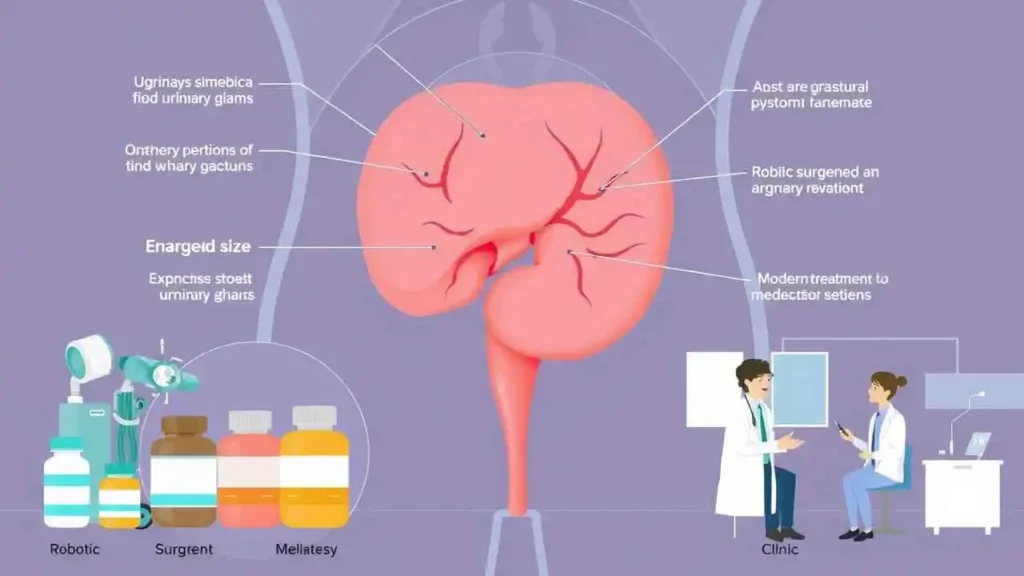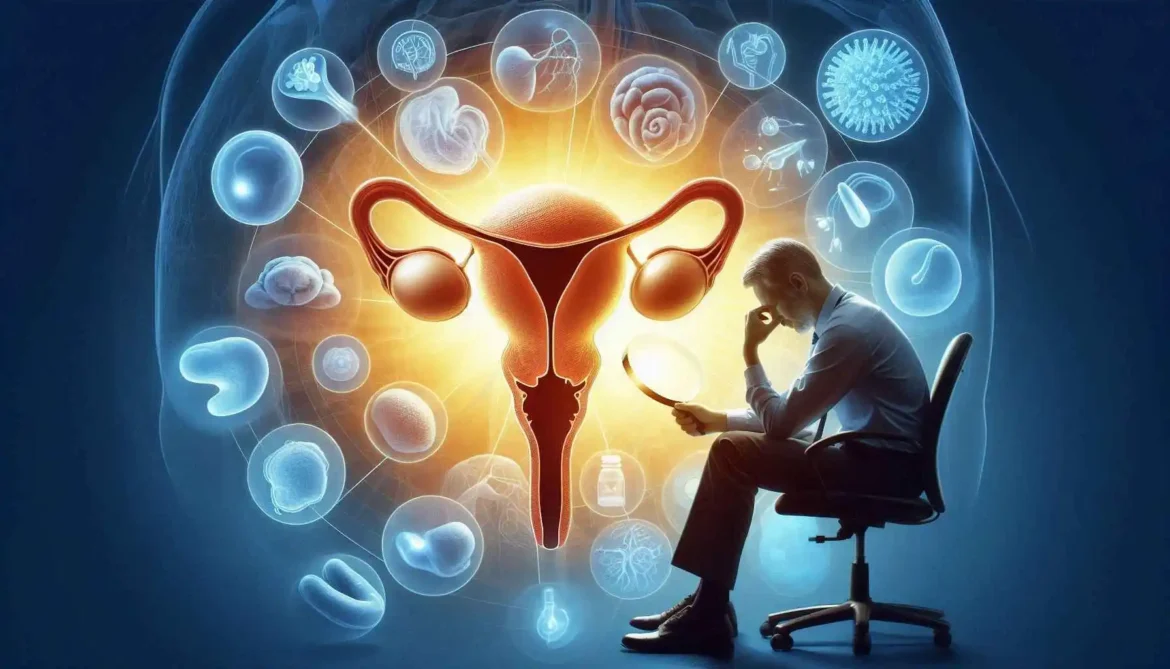
Understanding Prostate Diseases: Symptoms, Causes & Modern Treatments
As we age, particularly into our later years, various aspects of our physical health become increasingly important to monitor and understand. For men, one vital part of this health landscape is the prostate gland. Often overlooked until issues arise, the prostate plays a key role in the male reproductive and urinary systems. Navigating the potential challenges related to prostate health, from common benign conditions to more serious concerns like cancer, requires knowledge and proactive care.
In this article, we will delve into the world of prostate health. We’ll explore what the prostate is, discuss the most common diseases it can be affected by, examine their potential causes and risk factors, outline the symptoms we should be aware of, and touch upon the various diagnostic methods and treatment options available to us. Understanding these aspects empowers us to take control of our health and seek appropriate medical attention when needed.
What is the Prostate?
Let’s start with the basics. The prostate is a small gland, typically about the size and shape of a walnut, located deep within the male pelvis. It sits just below the bladder and completely surrounds the upper part of the urethra, the tube that carries urine from the bladder out of the body. The prostate is also situated in front of the rectum, which is why certain examinations involve the rectum.
The primary function of the prostate gland is to produce seminal fluid, a milky liquid that makes up a significant portion of semen. This fluid helps to nourish and transport sperm during ejaculation. Because of its location surrounding the urethra, any changes in the size or health of the prostate gland can directly impact our urinary function.
Common Prostate Diseases We May Encounter
The prostate can be affected by several conditions, which often become more common as we get older. The three main issues we frequently hear about are Benign Prostatic Hyperplasia, Prostatitis, and Prostate Cancer.
- Benign Prostatic Hyperplasia (BPH): This is perhaps the most common prostate problem we encounter as we age. BPH is a non-cancerous enlargement of the prostate gland. As the prostate grows, it can squeeze the urethra, obstructing the flow of urine from the bladder. While almost all men will develop some degree of prostate enlargement as they get older, not all will experience bothersome symptoms. It’s crucial to understand that BPH is not cancer and does not increase the risk of developing prostate cancer, although it is possible to have both conditions simultaneously.
- Prostatitis: This refers to the inflammation of the prostate gland. Prostatitis can affect men of all ages, though it is more common in men younger than 50. There are several types, including:
- Acute Bacterial Prostatitis: A sudden bacterial infection causing significant pain and urinary symptoms.
- Chronic Bacterial Prostatitis: Recurrent bacterial infections in the prostate.
- Chronic Prostatitis/Chronic Pelvic Pain Syndrome (CP/CPPS): The most common but least understood type, involving ongoing pain in the pelvic area without evidence of infection.
- Asymptomatic Inflammatory Prostatitis: Inflammation detected incidentally, often during tests for other conditions, without causing symptoms.
- Prostate Cancer: This is the most common cancer among men, excluding skin cancer. Prostate cancer typically starts in the gland cells of the prostate. Many prostate cancers grow slowly and may remain confined to the prostate gland, posing minimal risk. However, some types can be aggressive and spread quickly to other parts of the body. Early detection is often key for successful treatment.
Causes and Risk Factors We Should Be Aware Of
While the exact causes of some prostate conditions, like BPH and certain types of prostatitis, are not fully understood, several factors are known to increase our risk:
- Age: This is the most significant risk factor for both BPH and prostate cancer. The likelihood of developing BPH symptoms and being diagnosed with prostate cancer increases significantly after age 50.
- Family History: If our father or a brother had prostate cancer, especially if diagnosed before age 65, our risk is elevated. The risk is also higher if we have a family history of other related cancers (like breast or ovarian cancer) linked to inherited gene mutations (e.g., BRCA1 or BRCA2).
- Ethnicity: African American men have a higher incidence of prostate cancer and are more likely to be diagnosed at an advanced stage. The reasons for this are complex and likely involve a mix of genetic, environmental, and socioeconomic factors.
- Lifestyle and Diet: While research is ongoing, some studies suggest that a diet high in red meat, high-fat dairy products, and processed foods may increase the risk of prostate cancer. Obesity may also be linked to a higher risk of aggressive prostate cancer. A diet rich in fruits, vegetables, and healthy fats may be protective. Chronic inflammation, potentially linked to diet or other factors, might play a role in both prostatitis and prostate cancer risk.
- Infections: Bacterial infections are a direct cause of bacterial prostatitis. While not a direct cause of BPH or cancer, chronic inflammation (sometimes stemming from past infections) might contribute to the risk of other prostate issues over time.
. Lack of Exercise : A sedentary lifestyle can contribute to weight gain and obesity, both of which are risk factors for prostate health issues.
. Hormonal Changes : Changes in hormone levels, particularly an increase in dihydrotestosterone (DHT), can lead to prostate enlargement and other health issues.
- Smoking :Smoking can increase the risk of prostate cancer and other prostate-related health issues.
Symptoms: What Our Body Tries to Tell Us
The symptoms of prostate problems often overlap because the prostate surrounds the urethra. Many symptoms relate to changes in urination. Recognizing these signs early is crucial for timely diagnosis and treatment.
Common symptoms we might experience include:
- Frequent urination, especially at night (nocturia)
- Difficulty starting urination (hesitancy)
- A weak or interrupted urine stream
- A feeling that we cannot completely empty our bladder
- Urgency – a sudden, strong need to urinate
- Dribbling after urination ends
- Pain or burning during urination (dysuria)
- Pain in the lower back, hips, pelvic area, or upper thighs (can be associated with prostatitis or advanced prostate cancer)
- Pain during ejaculation (often associated with prostatitis)
- Blood in the urine or semen (hematuria or hematospermia) – while potentially alarming, this can be caused by infection, inflammation, or benign conditions as well as cancer.
It’s important to note that early-stage prostate cancer often produces no symptoms. Symptoms usually only appear when the cancer has grown large enough to affect the urethra or has spread outside the prostate. Therefore, relying solely on symptoms is not a strategy for early detection of cancer.
Here’s a table summarizing common symptoms associated with the main prostate conditions:
| Condition | Common Symptoms |
| Benign Prostatic Hyperplasia (BPH) | Frequent urination (especially nocturnal), urgency, weak/interrupted stream, difficulty starting urination, feeling of incomplete emptying, dribbling. |
| Prostatitis | Pain or burning during urination, difficulty urinating, frequent urination, urgency, pain in the groin, pelvic area, lower back, or genitals, pain during ejaculation, flu-like symptoms (acute bacterial). |
| Prostate Cancer | Often asymptomatic in early stages. Later symptoms can include difficulty starting/stopping urination, weak flow, frequent urination (especially at night), blood in urine/semen, painful ejaculation, pain in back, hips, pelvis if spread. |
Diagnosis: How We Find Out What’s Happening
If we experience potential symptoms or are due for routine screening, our doctor will use various methods to evaluate our prostate health.
Diagnosis typically involves:
- Medical History and Physical Exam: Our doctor will ask about our symptoms and medical history. A Digital Rectal Exam (DRE) is performed, where the doctor gently inserts a gloved, lubricated finger into the rectum to feel the prostate for size, shape, and any abnormalities.
- Prostate-Specific Antigen (PSA) Test: This is a blood test that measures the level of PSA, a protein produced by prostate cells. Elevated PSA levels can indicate prostate cancer, BPH, or prostatitis. It’s not a perfect test, as many factors can influence PSA levels, and elevated PSA doesn’t automatically mean cancer. Discussion with our doctor about the pros and cons of PSA testing is vital.
- Urine Tests: Analyzing a urine sample can help detect infections (common in bacterial prostatitis) or blood.
- Imaging Tests: Ultrasound, MRI, or other imaging techniques can help assess prostate size, identify suspicious areas, and check if cancer has spread.
- Prostate Biopsy: If PSA levels are high or a DRE reveals an abnormality, a biopsy may be recommended. This involves taking small tissue samples from the prostate with a needle, which are then examined under a microscope to check for cancer cells. This is the only definitive way to diagnose prostate cancer.
Treatment Options We Might Consider
Treatment approaches for prostate issues vary greatly depending on the specific condition, its severity, our age, overall health, and our preferences.
- For BPH:
- Watchful Waiting: For mild symptoms, we might simply monitor the condition over time.
- Medications: Alpha-blockers relax muscles in the prostate and bladder neck to improve urine flow. 5-alpha reductase inhibitors shrink the prostate gland.
- Minimally Invasive Procedures: Various procedures use heat, lasers, or other methods to remove or destroy excess prostate tissue.
- Surgery: Transurethral Resection of the Prostate (TURP) is a common surgery where a part of the prostate is removed using a scope inserted through the urethra. Other surgical options exist for very large prostates.
- For Prostatitis:
- Antibiotics: Used to treat bacterial prostatitis. The course can range from a few weeks to several months for chronic cases.
- Anti-inflammatories and Pain Relievers: Medications like ibuprofen can help manage pain and inflammation.
- Alpha-blockers: Can help relax muscles to ease urinary symptoms.
- Lifestyle Modifications: Warm baths, dietary changes, and avoiding irritants can sometimes help.
- For Prostate Cancer: Treatment decisions are complex and based on the cancer’s stage, grade (how aggressive it looks under a microscope), our age, and overall health.
- Active Surveillance: For low-risk, slow-growing cancers, we might choose to monitor the cancer with regular PSA tests, DREs, and sometimes repeat biopsies, delaying or avoiding treatment.
- Surgery: Radical prostatectomy is the removal of the entire prostate gland and sometimes nearby lymph nodes. This can be done through open surgery or minimally invasive (laparoscopic or robotic) techniques.
- Radiation Therapy: Using high-energy rays to kill cancer cells. This can be external beam radiation (delivered from outside the body) or brachytherapy (placing radioactive seeds inside the prostate).
- Hormone Therapy: Aims to lower the levels of male hormones (androgens), which prostate cancer cells often need to grow. This is often used for more advanced cancer or in combination with radiation.
- Chemotherapy: Used for advanced prostate cancer that has spread outside the prostate and is no longer responding to hormone therapy.
- Immunotherapy and Targeted Therapy: Newer treatments that use our body’s own immune system or target specific cancer cell characteristics.
Maintaining Our Prostate Health
While we cannot eliminate all risk factors, especially age and genetics, there are steps we can take to support our overall prostate health and potentially lower our risk of certain conditions:
- Adopt a healthy diet rich in fruits, vegetables, and whole grains.
- Limit our intake of red meat, high-fat dairy, and processed foods.
- Maintain a healthy weight.
- Exercise regularly.
- Stay well-hydrated.
- Quit smoking.
- Manage stress.
- Most importantly: Discuss prostate cancer screening (PSA test and DRE) with our doctor to make an informed decision based on our individual risk factors and health status. We should also be aware of potential symptoms and report any changes to our doctor promptly.
As we reflect on the importance of awareness regarding prostate health, a crucial truth stands out:
Ignoring a health issue doesn’t make it disappear. Early detection and intervention are often the most effective path to positive outcomes.





